T-60 returned to service
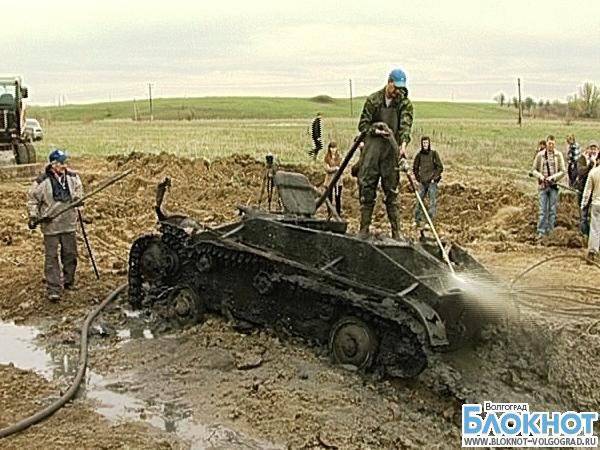
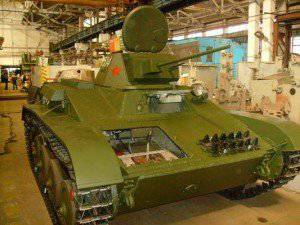
The restored T-60 tank has replenished the collection of military equipment of the Battle of Stalingrad museum-reserve. A unique relic was restored for two years at a special machine-building plant. The staff of the enterprise has reconstructed the engine tankrunning gear. Especially for the repair of the T-60, the factory workers installed special scaffolding, built a platform of a special shape and even assembled the tracks in their own way. They made a one-time blank and manually cast every centimeter.
Experts say that the tank was recreated according to the technical documents that were found in the archives of the plant. By the way, it was at the Stalingrad Shipyard, the heir to which the Volgograd Plant of Special Mechanical Engineering became the heir, that produced the armored hull of the T-60 tanks during the Great Patriotic War.
“The machine is fully operational, the tank is on the move and can take part in reconstructions that are carried out within the framework of the work of the Russian military-historical society,” the museum-reserve press service told All for You. - T-60 was delivered to us in KamAZ, but the tank, which was controlled by a plant specialist, moved off the truck independently.
At T-60, who took the place of honor at the main entrance to the museum-panorama "Battle of Stalingrad", not an easy fate. Its parts were raised by search engines in the spring of 2011 from the bottom of the Good River in the Surovikinsky district. Then almost the entire Kiselev farm was going to look at the operation. People said that before they sank in a local stream, the tank stood on the bank for years.
“I remember how for several years after the war this tank was abandoned, and we children dived into the river from it,” says Lyubov Frolova, a resident of the village of Kiselev. - Then he sank. And old-timers say that they even saw how he was hit. The tower was demolished, but the crew managed to jump out of the burning car.
- Unfortunately, story we are not yet aware of the crew’s crew, the work to restore the names of tank heroes remains to be done by museum researchers, ”said Alexey Vasin, director of the Stalingrad Battle Museum-Reserve.
The rebuilt T-60 is the only tank of such armored vehicles that have survived to the present, which actually took part in the Battle of Stalingrad. It was developed in August 1941 of the year at the Moscow plant number 37 under the leadership of Nikolay Astrov. In September of the same year, the T-60 was adopted by the Red Army and mass-produced at several machine-building plants. Production of the T-60 continued until February of the 1943 year. In total 5920 of such tanks was released. Soon after the end of the war, the armored vehicle was decommissioned.
A small number of T-60 survivors were used as reconnaissance tanks, tractors, training vehicles until the end of the war. It is known that the Soviet tankers because of light armor and weapons did not complain too much about the T-60, calling it "BM-2" - "a mass grave for two." And the German troops called the T-60 "indestructible locust."
According to some information, only six such tanks have survived in the world, they are in museums of Russia and Finland.
The history of the creation and combat use of this machine is widely and well known. T-60 - Soviet light tank during the Second World War. This combat vehicle was developed in August 1941 of the year at the Moscow plant number 37 under the leadership of Nikolai Aleksandrovich Astrov, the leading developer of the entire domestic line of light tanks of that period. In September of the same year, the T-60 was adopted by the Workers 'and Peasants' Red Army and mass-produced in several machine-building plants. Production of the T-60 continued until February of the 1943 year, when it was replaced on the assembly lines with a more powerful light tank T-70. In total, 5920 T-60 light tanks were launched, which took an active part in the battles of World War II 1941 — 1943. A small number of survivors in the T-60 battles were used as reconnaissance tanks, tractors, training vehicles until the end of the war. On the basis of the T-60 in 1941, the first self-propelled BM-8-24 class of multiple launch rocket systems on a tank chassis was built. Shortly after the end of the war, the T-60 was removed from the arsenal of the Soviet Army.
Just three days after the start of World War II, 25 June 1941, Moscow Plant No. 37 received an order to discontinue the light (according to the current classification of a small floating tank) T-40 and start refitting factory production facilities for the production of a light tank that directly supports infantry T-50. However, the implementation of this solution required the complete reconstruction of Plant No. 37 and the supplying plant of armored hulls, which was completely unacceptable under the current situation. Moreover, the staff of the plant number 37 with great difficulty coping with the plans for the release of relatively simple in design T-40 tank. The production of T-50 was an order of magnitude more difficult in terms of technology, which only complicated the task
Therefore, N. A. Astrov, Chief Designer of Plant No. 37, from the very beginning saw the futility of attempting to master the T-50 serial production at his enterprise. Instead, he and the staff of his design office for two weeks at the end of July 1941, designed and manufactured a prototype of a new light tank based on the T-40 amphibious tank that was mastered at the factory. From the latter were borrowed layout, chassis components, transmissions, electrical equipment and installation of weapons. Due to the rejection of the possibility of movement afloat (at the beginning of the war, T-40 was practically not used as such) the thickness of the front armored plates of the tank was installed at more favorable angles. Initially, the weapons remained the same as compared with the T-40 - one 12,7-mm heavy machine gun DShK and one 7,62-mm machine gun DT. After coordination with the representative of the military acceptance V.P. Okunev, N.A. Astrov wrote a letter addressed to JV Stalin with information about the new machine and the proposal for its release at the plant No. 37 instead of T-50.
In the further history of the creation of the T-60, expert opinions differ.
There are two options for presenting events, one canonical, set forth in the articles by E. I. Prochko and I. G. Zheltova with co-authors, and the second is put forward by the famous Russian historian M. N. Svirin.
According to the canonical version, the first prototype of the new tank built under the factory designation 0-60 the very next day was demonstrated to the People's Commissar of the tank industry V. Malyshev and he was the prototype of the serial T-60. M. N. Svirin, on the basis of an analysis of the documents of the People’s Commissariat of the Tank Industry, claims that the designation “T-60” was originally assigned to the prototype of the land version of the T-40 tank under the factory index 0-30, the production version of which is now known as T-40С or T -30. According to this assumption, it was the land version of the T-40 with enhanced armor that was shown to V. A. Malyshev; and that machine, which is now known as the T-60, was developed later. As a result, the time from the start of work on the T-60 (first “land” 0-30 and only then the “reduced case” 0-60) to the construction of the prototype 0-60 was more than two weeks. However, these two weeks, widely mentioned in publications, have as their primary source the memoirs of N. A. Astrov and may well relate to the final phase of development, when the 0-30 was launched into a series and the designers worked only on the “reduced case”.
Except for this ambiguity with the type of prototype shown to V.A. Malyshev, the authors mentioned later converge in the description of the events. V. A. Malyshev proposed to rearm the car aviation 20 mm ShVAK automatic cannon. He organized a meeting of N. A. Astrov with aircraft designers from OKB-15 and OKB-16 to study the issue of installing a ShVAK gun in a tank. An interesting fact in the designer’s memoirs is the remark that he had to persuade the designer of the airborne armament Shpitalny, “a man of great grandeur”, in order to develop a tank version of the ShVAK air gun.
One way or another, as a result of joint actions, a tank version of this weapon was created. It was installed on the second prototype of the 0-60 tank, which was shown to Supreme Commander JV Stalin in tests. In the shortest possible time, they were completed and the tank was adopted by the T-60 index by a decision of the State Defense Committee. The plants No. 37, 264 (Red Army Shipbuilding in Sarepta), Gorky Automobile (GAZ) and Kharkov Tractor (HTZ) were ordered to manufacture 10000 T-60 type tanks. To familiarize with the tank design, Plant No. 37 has released pre-production samples of T-60 for GAS and XTZ.
Subsequently, the 20-mm gun was still constructively refined until December 1941, inclusive, when it was officially put into service under the designation TNSh (or TNSh-1 - Nudelman-Spit Tank).
However, for the deployment of mass production of new tanks there was not enough design drawings and documentation. These materials were prepared in September — October 1941 by the plant team No. 37 already under the German bombardment of Moscow and on the verge of evacuation. N.A. Astrov, Chief Designer of Plant No. 37, personally overtook the experienced T-60 from Moscow to Gorky (this was credited as sea tests of the tank) and in mid-October a set of design and technological documentation was also delivered there. GAZ designers, headed by A. M. Krieger (also A. Ya. Freidlin, S. A. Batanov, K. M. Chivkunov) have done a great deal of work to further simplify the design of the T-60 tank and its adaptation to the production capabilities of GAZ. In November 1941, the first serial Gorky "sixties" were delivered to the troops. It was the designers of GAZ who developed an efficient engine preheater, which has become an integral feature of all further machines designed by N. A. Astrov. Since October, the chief designer himself, 1941, has been working on further improving the combat capabilities of the light tank. These works in December 1941 ended with the creation of a light tank T-70, which used quite a lot of components and assemblies from the "sixties" just mastered in production
With the launch of the series, the further development of the T-60 was continued, since its booking and arming did not meet the requirements of the time. The thickness of the armor plates of the front plates with the lowest angles of inclination and the front zygomatic edges of the tower, which are most susceptible to enemy fire, were increased from 25 to 35 mm. According to the proposal of SRI-48, on the frontal part of the hull and the T-60 turret of a later release, armor screens with a thickness of 10 mm were installed. The shielding was done in such a way that there was an air gap between the screen and the armored hull, that is, the T-60 became a tank with spaced booking. This configuration of protective elements made it possible to more effectively resist armor-piercing projectiles - the screen destroyed the tip of the projectile and reduced its normalization, while the main armor held up the projectile or its fragments. This improvement was welcomed by the troops at the front. With armament, things were not so successful - on the experimental T-60 tanks, various more powerful weapons were tested compared to the standard TNS, but none of them were accepted for serial production. After the appearance of the new T-70 light tank, this work continued in relation to it, and the emphasis in improving the T-60 shifted towards the creation of self-propelled artillery and anti-aircraft guns at its base.
After the development of the T-60 light tank, the Moscow plant No. 37 produced 20 vehicles of this type, after which in November 1941 began its evacuation to Sverdlovsk. The T-60 armored case for plant No. 37 in Moscow was produced by the Kolomna Kuybyshev Machine-Building Plant. In October, his shop 1941, engaged in the production of armored hulls for T-60, were evacuated to Kirov to the site of the Kirov Machine-Building Plant of the People’s Commissariat of Communications named after 1 May. On the basis of these two enterprises, a new plant No. 38 was created, which in January 1942 built its first T-60 tanks according to the drawings of Plant No. 37. Krasnoarmeysky Shipbuilding Plant (No. 264) in Sarepta near Stalingrad also launched the production of T-60 light tanks. The largest number of light tanks T-60 in 1941 — 1942. built gaz. In participated Podolsky and Izhorsk plants (for Moscow Plant № 60), Vyksunsky plant (for gas) Novokramatorsky Engineering, Voroshilovgradsky locomotive and Mariupol Metallurgical Ilyich (for HTZ) as allied to the process of manufacturing hulls and towers T-37. 20-mm guns came from Kovrovsky Plant No. 2, Tula Arms Plant No. 535, Mednogorsk Plant No. 314 and Kuibyshevsky Plant No. 525. Trucks were made at the Dzerzhinsky Stalingrad Tractor Plant
Combat application
In the Workers 'and Peasants' Red Army
For the first time, T-60 went into battle in September of the 1941 of the year as part of the 10-th tank brigade operating in the Poltava region. In large quantities, they participated in the battles of 1941 — 1943, beginning with the battle for Moscow, and ending with the full de-deployment of Leningrad in January of 1944. Especially great was the role of the T-60 in the defense of Moscow - due to the catastrophic loss of material and the evacuation of tank factories, the level of production of medium and heavy tanks fell sharply, not covering even the minimum requirements of the Red Army in these combat vehicles. As a result, they were replaced by lighter "sixties". In the course of the November 7 parade on the Red Square, 1941 passed from the T-48 reserve took place on Red Square. After the parade, they were immediately sent to the front. December 60 13, after the start of the counteroffensive of the Soviet troops, the first T-1941 fired at Gorky took part in the battles near Moscow
During the 1942 campaign of the year, T-60 was used on all fronts, ranging from besieged Leningrad to the lost Crimea. In the besieged Leningrad, the "sixties" were delivered by river, disguised on barges with coal, which did not cause special interest to the dominant German aircraft. Thus, unnoticed by the enemy, the 61 tank tank brigade was moved. T-60 was actively used during all phases of the Stalingrad battle and its tragic prelude for the Red Army - the Kharkov operation on the Barvenkovsky ledge. The losses were high, since by that time the German anti-tank guns, tanks and self-propelled guns were far superior in class T-60. It is quite natural that Soviet tankers, because of light armor and armament, did not complain too much about the T-60, calling it BM-2 - “common grave for two” (however, “common graves” call all tanks).
On the other hand, T-60 had almost no operational claims, which was more than frequent in relation to T-34 and KV-1. There were tankers who liked the T-60 - for example, the “sixties” 91 tank brigade wore such names as “Terrible”, “Eagle”, “Brave”. By the end of the 1942, the T-60 was gradually removed from the advanced as the T-34 troops, whose output increased many times over, and the new, more combat-ready model of the light tank T-70. In turn, German troops also appreciated if not the quality, then the quantity of T-60 and called them “locust”
The T-60 continued to be actively used over the next 1943 year. The sixties highlight was the break-through of the blockade of Leningrad, which began on January 12, 1943. Then the 61 tank tank brigade mentioned above went into battle along with the 86 and 118 units of the individual tank battalions. These units acted in the first echelon of the 67 Army and on the first day, crossing the Neva, they captured a bridgehead of 2 — 3 km. In this case, only light tanks were used, since it was they who had the most necessary advantage at that moment — low specific pressure on the supporting surface. This allowed the Soviet cars to pass the Neva on the ice without preparation. Medium and heavy tanks were able to join the battle only the next day, when engineering and engineer units prepared reinforcing flooring for them to cross the Neva. The tanks of the 61 Brigade were the first to unite with units of the Volkhov Front, and for this success it received the title of the Guards. The shortcomings and merits of the T-60, as well as the courage of its crew as part of the commander Lieutenant D.I. Osatyuk and the mechanic driver foreman I.M. Makarenkov during these battles are shown in the following fragment from the book “Tankers in the battle for Leningrad”
Breaking forward, at dawn 18 in January, at the workers' settlement number 5, they noticed three tanks. Volkhovtsy wanted to jump out of the car, to run towards, but they saw that it was Hitler’s tanks going to counterattack. What to do? Starting a fight with the enemy on your baby with an 20-mm gun is pointless. The decision matured instantly. The tank commander gave the command to the driver: “Go to that grove, on the edge of which our guns occupied firing positions!”
The tank, maneuvering, making unexpected and sharp turns, escaped the fire of Hitler’s tanks, while Osatyuk fired at them, trying to blind, stun the enemy. The duel lasted a few minutes. There were moments when it seemed that armored monsters were about to overtake, collapse and crush. When it was about 200 meters before the grove, Osatyuk's car turned sharply to the left. The Hitlerite head tank also turned around, but came under fire from our guns and flamed. Then the second tank was hit, and the third left the battlefield.
“Now, Vanyusha, go ahead!” The commander ordered the driver. Having caught up with their company, they saw an interesting picture - the tankers had driven the enemy’s infantry into a huge pit. The Nazis stubbornly resisted, bombarded our tanks with grenades. It was clear that it was impossible to hesitate, the fascists would have time to dig in. Osatyuk orders Makarenkov to roll a trail to the precipice, to lay a rut. Then the tank, picking up speed, rushed to the pit, flew in the air and crashed into the fascists.
"Well done! - shouted the lieutenant - Now act!". The car rushed at high speed along the bottom of the pit, destroying the Nazis with fire and caterpillars. Having made a few laps, the tank slowed down, went into the middle of the pit and stopped. It was all over. Come your own.
For this fight, the crew in full force was awarded the honorary titles of the Hero of the Soviet Union. It is worth noting that the light tank T-60 №164 T-60 D.I. Osatyuk, one of the first to reach the Big Earth, survived the war and from March 1947 was exhibited in the Museum of the Defense of Leningrad. However, after the liquidation of the museum, this tank disappeared without a trace.
In general, the Volkhov and especially the Leningrad fronts retained a large number of old cars in their ranks up to and including 1944. BT-7, T-38 and single T-28, KV-1 of the first releases and a large number of T-60, which on the other fronts were not the first-line tanks and performed other functions, participated in the operation on the final lifting of the blockade of Leningrad. For example, almost a quarter (21 of 88) of the 1 tank tank brigade of the Leningrad Front were exactly the “sixties”.
Participated T-60 and the Battle of Kursk. So, the 1 tank army had 18 tanks of this type, the 86 tank brigade (Voronezh Front, 38 army) - 15 tanks.
Since the end of 1942, more and more new T-34 and T-70 tanks began to arrive in the army. As a result, the weaker T-60 began to translate into the most diverse work: escorting and guarding the troops on the march, reconnaissance by force, destruction of bandits and saboteurs in the rear. They were used as commander units of self-propelled artillery units equipped with SU-76 self-propelled guns and as training tanks in the rear. Also, the "sixties" were used as artillery tractors for anti-tank guns ZiS-2 and divisional ZiS-3. In this capacity, the surviving T-60 served until the end of World War II and took part in the defeat of the Kwantung Army of Imperial Japan in August 1945. Shortly after the end of the Second World War, the T-60 was decommissioned by the Red Army and sent to scrap. All the existing museum T-60 (with the exception of the prototype in Kubinka) were found shot down on the battlefield.
As exceptional, we can note the fact of the command of the T-60 tank unit, Irina Nikolaevna Levchenko. After being injured, Nurse Levchenko voluntarily entered a tank school and returned to the front, where she passed the military path from the commander of the "sixties" to the commander of the unit of these tanks. Irina Nikolaevna finished the war as a lieutenant colonel of the guard, was awarded three orders of the Red Star, ten medals, nominal weapons from the Minister of Defense of Bulgaria. After the war, she was awarded the title Hero of the Soviet Union and the Florence Nightingale medal from the International Committee of the Red Cross.
In other armies
Light tanks T-60 were in service with the Polish Army. In 1945, there were three tanks of this type behind it.
A much larger number of "sixties" served as war trophies in the Wehrmacht. In contrast to the frequently broken T-34 (and even more so KV-1) 1941 — 42 release. with diesel engines, reliable petrol T-60 with its fairly widespread automobile components and assemblies (a considerable number of GAZ trucks were operated in the territories seized by the Germans) fully satisfied the Wehrmacht as a high-speed armored tractor of anti-tank guns. Sometimes the Germans captured the tower from the captured "sixties" used as tractors. A number of captured T-60 were transferred to Romania, where their chassis were used to create TACAM ACS
small photo gallery of the tank from the author
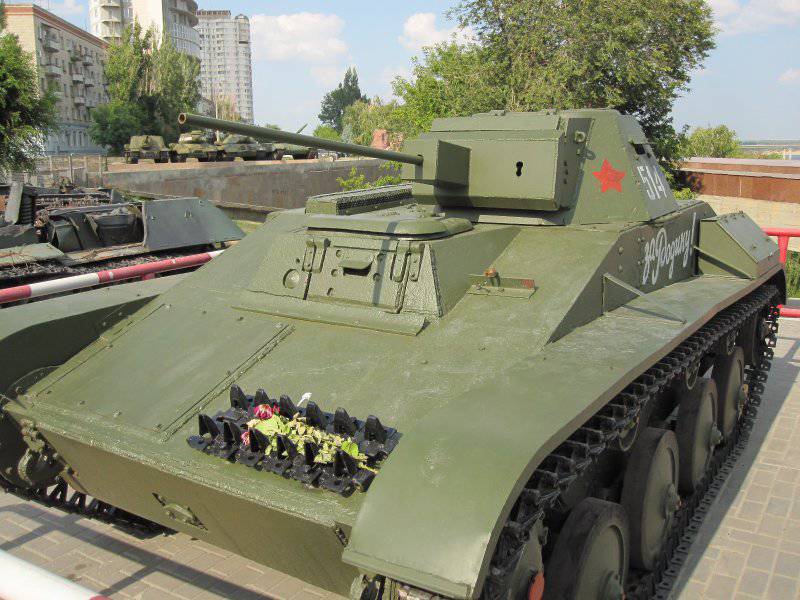
The overall impression is not bad, the tank is really restored to running status, everything is spoiled as usual, some details.
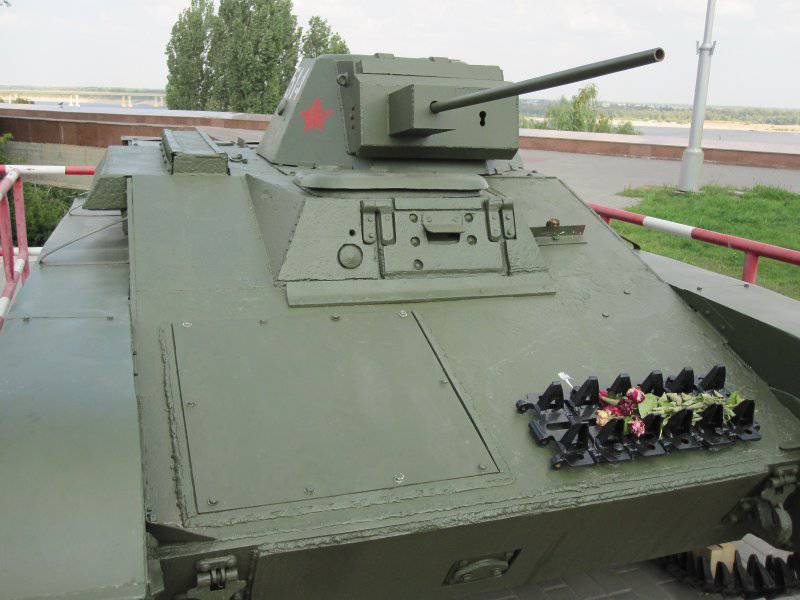
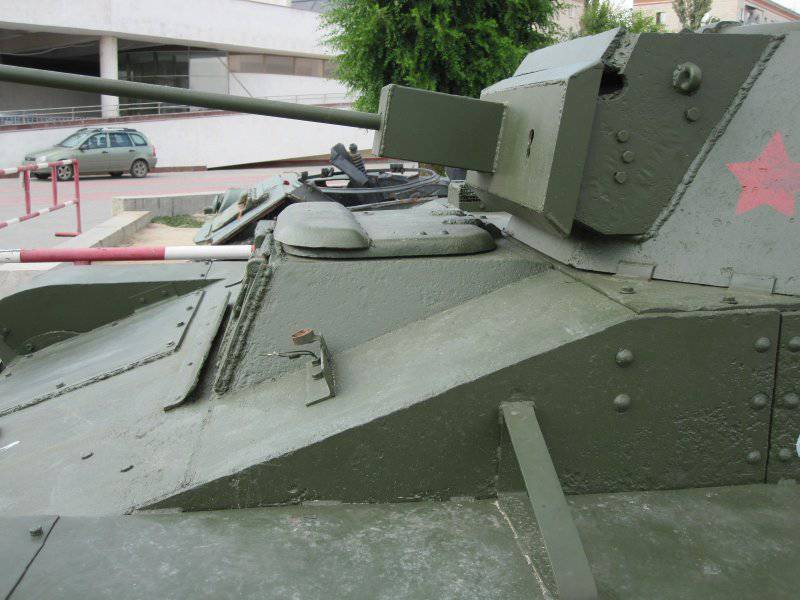
during the restoration of the tower, it is clear that no one began to restore the weapons, but why didn’t anyone bother to design the TNSh and its bookings at the required scale? A paired DT is not even in the form of a layout.
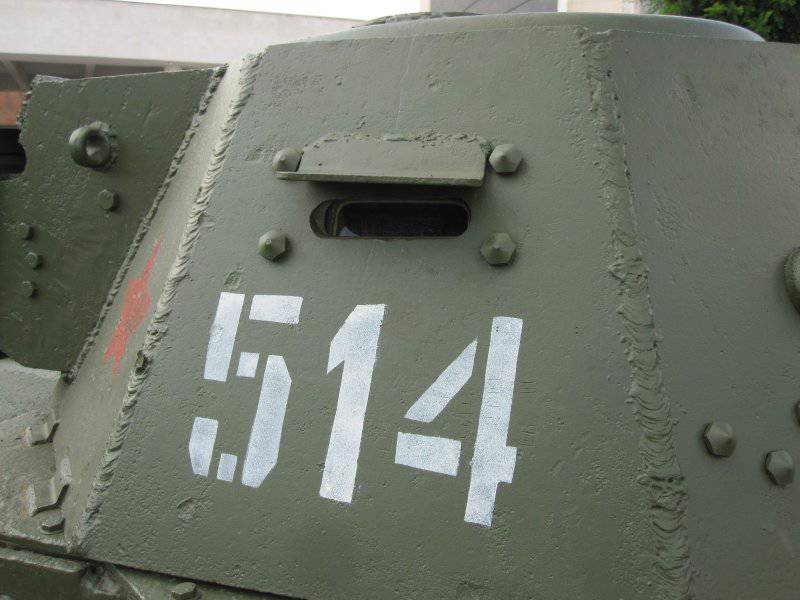
Even triplexes of viewing devices were restored in the tower, but at the same time the tower itself is tightly welded to the hull. Were too lazy to restore the epaulet? Or are they afraid that people will turn down the tower at the exposition?
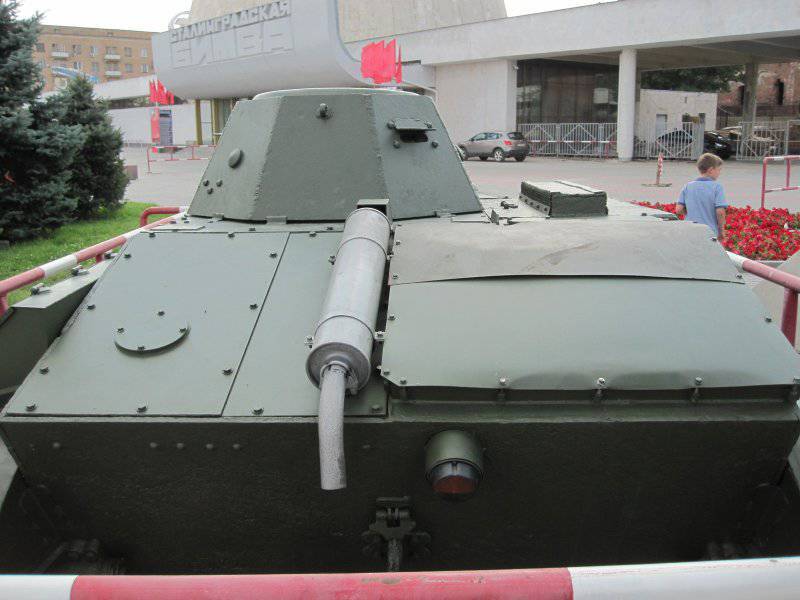
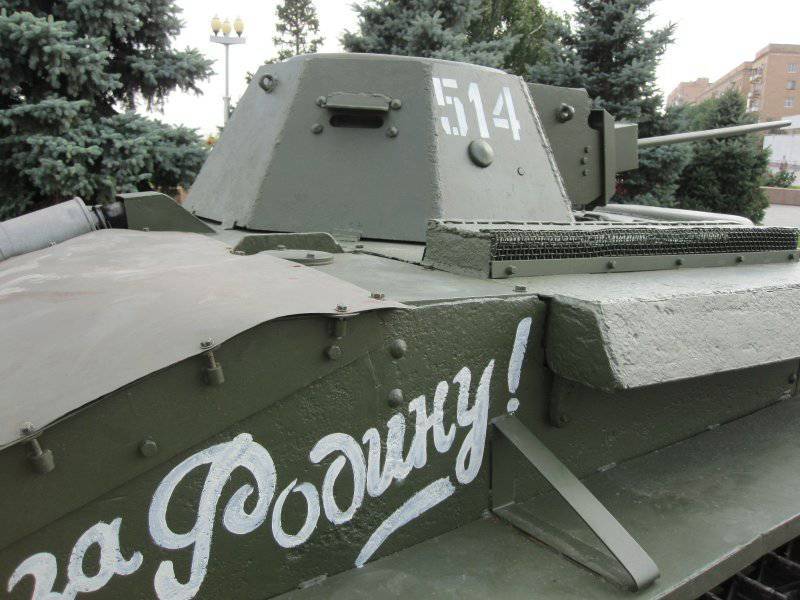
Aft blinds had to be closed with a piece of tin (well, at least dyed ...) And then the tanchik will be trodden down ... We still have a wild people ...
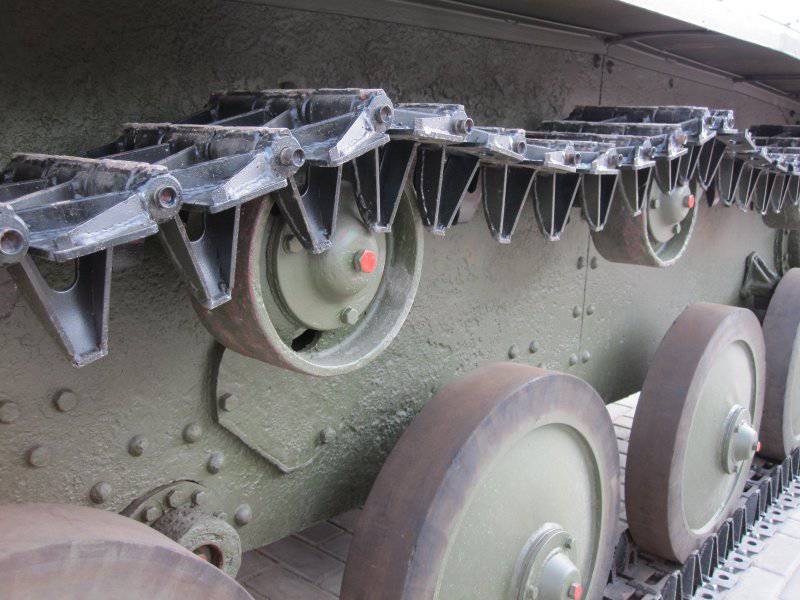
Chassis restored very well, though I really wonder why it was necessary to cook the tracks from the "cut". Found no casters?
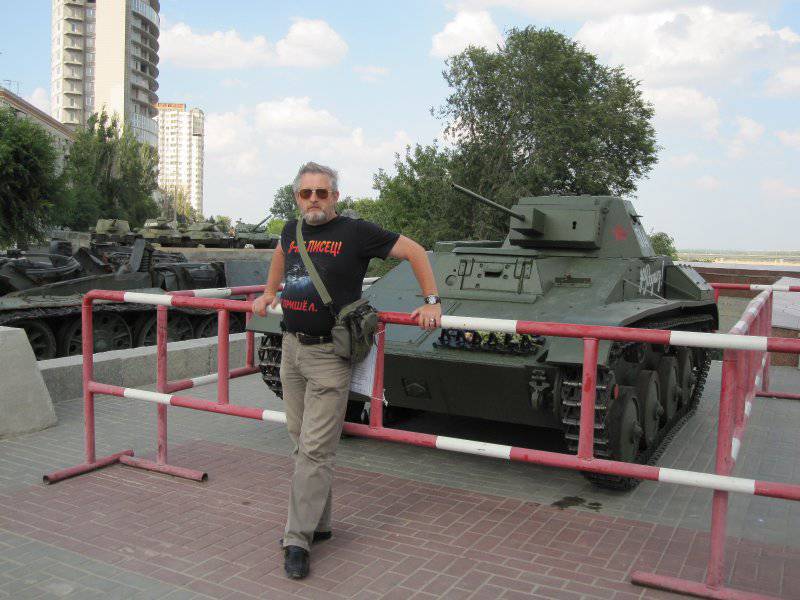
Well, and your humble servant actually next to the BM-2.
Materials used sites:
http://news.vdv-s.ru
http://www.dogswar.ru
Information